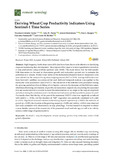JavaScript is disabled for your browser. Some features of this site may not work without it.
| dc.contributor.author | Vavlas, Nikolaos-Christos | |
| dc.contributor.author | Waine, Toby W. | |
| dc.contributor.author | Meersmans, Jeroen | |
| dc.contributor.author | Burgess, Paul J. | |
| dc.contributor.author | Fontanelli, Giacomo | |
| dc.contributor.author | Richter, Goetz M. | |
| dc.date.accessioned | 2020-09-07T11:18:27Z | |
| dc.date.available | 2020-09-07T11:18:27Z | |
| dc.date.issued | 2020-07-24 | |
| dc.identifier.citation | Vavlas NC, Waine TW, Meersmans J, et al., (2020) Deriving wheat crop productivity indicators using Sentinel-1 time series. Remote Sensing, Volume 12, Issue 15, Article number 2385 | en_UK |
| dc.identifier.issn | 2072-4292 | |
| dc.identifier.uri | https://doi.org/10.3390/rs12152385 | |
| dc.identifier.uri | http://dspace.lib.cranfield.ac.uk/handle/1826/15760 | |
| dc.description.abstract | High-frequency Earth observation (EO) data have been shown to be effective in identifying crops and monitoring their development. The purpose of this paper is to derive quantitative indicators of crop productivity using synthetic aperture radar (SAR). This study shows that the field-specific SAR time series can be used to characterise growth and maturation periods and to estimate the performance of cereals. Winter wheat fields on the Rothamsted Research farm in Harpenden (UK) were selected for the analysis during three cropping seasons (2017 to 2019). Average SAR backscatter from Sentinel-1 satellites was extracted for each field and temporal analysis was applied to the backscatter cross-polarisation ratio (VH/VV). The calculation of the different curve parameters during the growing period involves (i) fitting of two logistic curves to the dynamics of the SAR time series, which describe timing and intensity of growth and maturation, respectively; (ii) plotting the associated first and second derivative in order to assist the determination of key stages in the crop development; and (iii) exploring the correlation matrix for the derived indicators and their predictive power for yield. The results show that the day of the year of the maximum VH/VV value was negatively correlated with yield (r = −0.56), and the duration of “full” vegetation was positively correlated with yield (r = 0.61). Significant seasonal variation in the timing of peak vegetation (p = 0.042), the midpoint of growth (p = 0.037), the duration of the growing season (p = 0.039) and yield (p = 0.016) were observed and were consistent with observations of crop phenology. Further research is required to obtain a more detailed picture of the uncertainty of the presented novel methodology, as well as its validity across a wider range of agroecosystems | en_UK |
| dc.language.iso | en | en_UK |
| dc.publisher | MDPI | en_UK |
| dc.rights | Attribution 4.0 International | * |
| dc.rights.uri | http://creativecommons.org/licenses/by/4.0/ | * |
| dc.subject | growth dynamics | en_UK |
| dc.subject | SAR | en_UK |
| dc.subject | wheat | en_UK |
| dc.subject | productivity indicators | en_UK |
| dc.subject | remote sensing | en_UK |
| dc.subject | crop development | en_UK |
| dc.subject | Sentinel-1 | en_UK |
| dc.title | Deriving wheat crop productivity indicators using Sentinel-1 time series | en_UK |
| dc.type | Article | en_UK |
Files in this item
The following license files are associated with this item:
This item appears in the following Collection(s)
-
Staff publications (SWEE) [2822]

